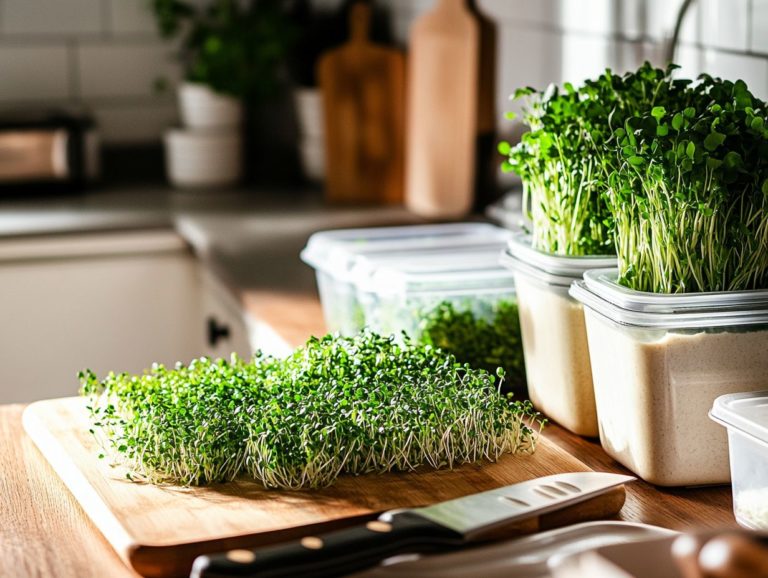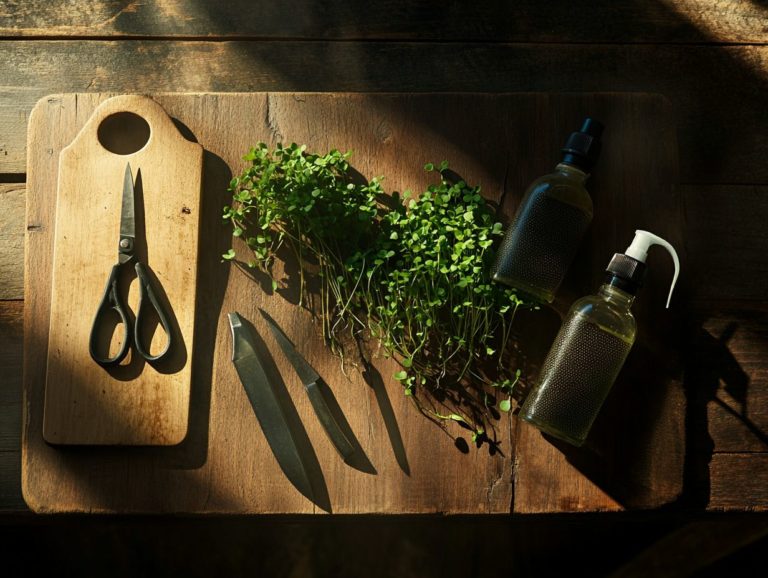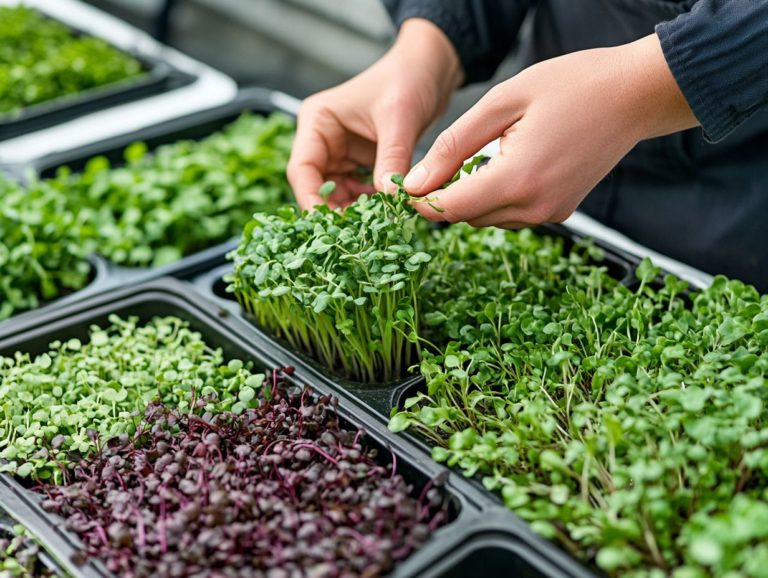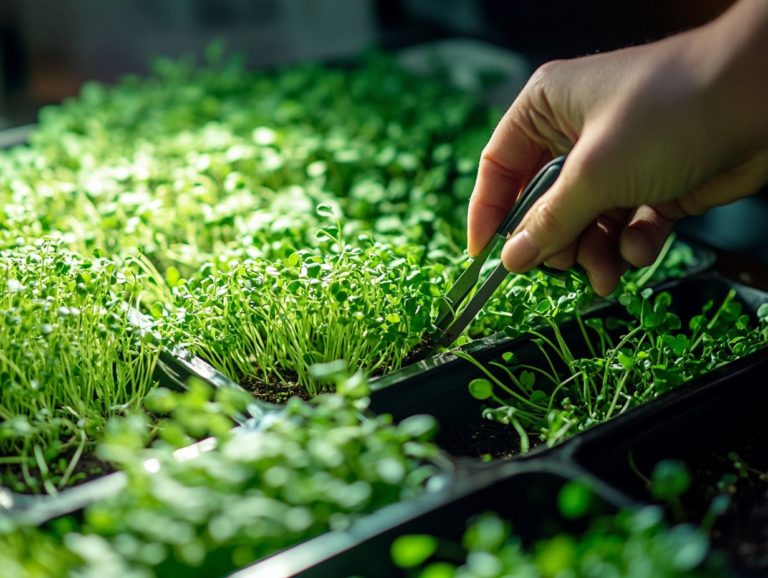How to Harvest Microgreens for Optimal Flavor
Microgreens are small but powerful plants. They are often called baby greens and are bursting with nutrients that can transform your meals with their vibrant flavors and colors.
This article delves into the essence of microgreens, focusing on their health benefits. You ll discover how to select the right varieties to suit your taste. Get ready to learn the ideal timing for harvesting to maximize flavor and the most effective techniques to preserve their nutritional value.
You ll also find useful tips on storage, washing, and creative culinary uses, allowing you to relish your microgreen harvest to its fullest potential.
Contents
Key Takeaways:
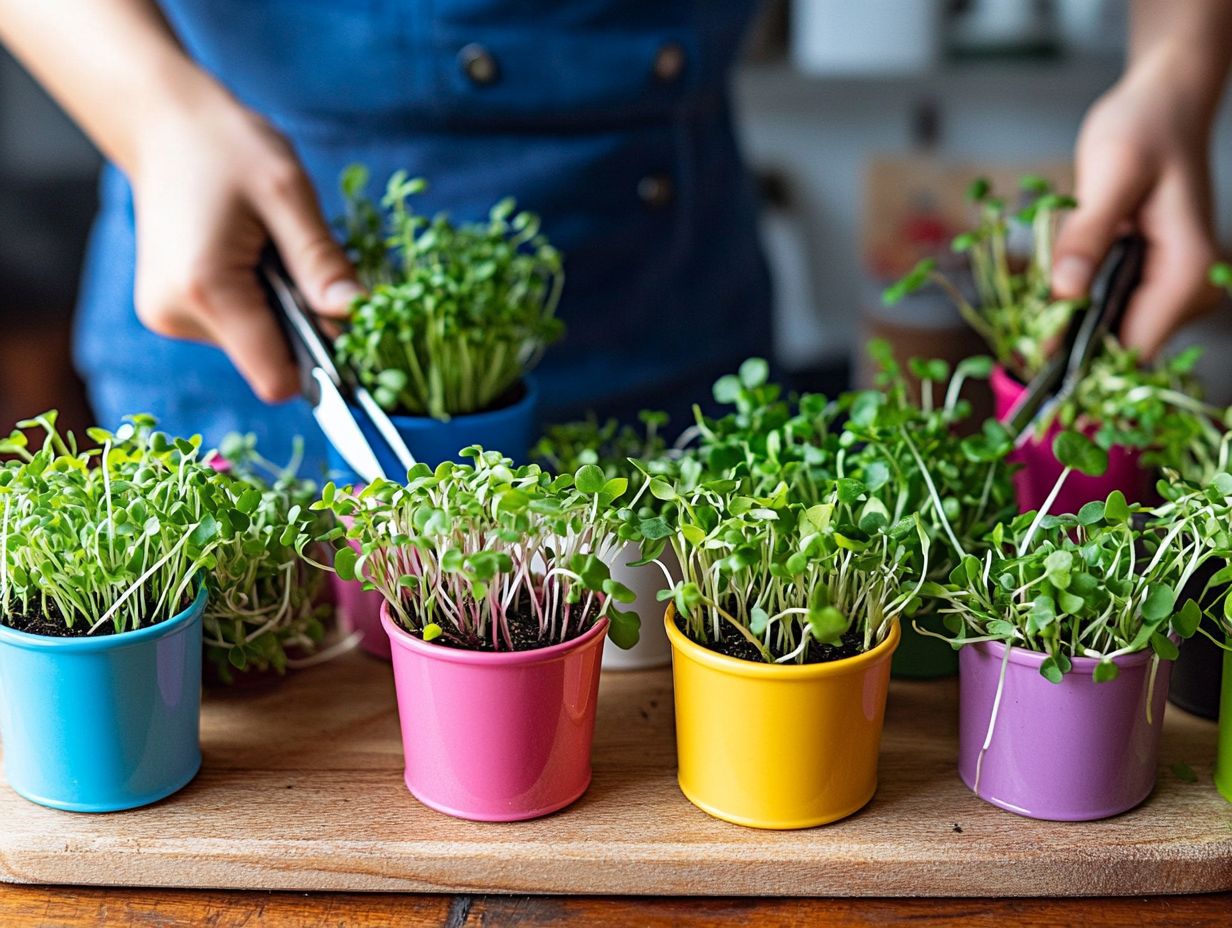
- Choose microgreen varieties, such as Arugula and Radish Microgreens, known for their strong flavor and nutritional value for the best harvest.
- Timing is crucial when harvesting microgreens. Picking them at the ideal growth stage ensures maximum flavor intensity and nutrient content.
- Harvest microgreens using gentle techniques to preserve their delicate texture and flavor. Cut them carefully and store them properly for lasting freshness.
What are Microgreens?
Microgreens are young, edible plants you can harvest shortly after germination. They typically feature the first leaves that appear alongside one or two true leaves. These vibrant greens are a nutrient-dense addition to your culinary repertoire.
Celebrated for their bold flavors and health benefits, microgreens can elevate the taste of salads, sandwiches, and gourmet dishes alike. To maximize your harvest, it’s important to learn how to rotate crops for microgreens. Their rapid growth stages allow anyone, whether a home gardener or health enthusiast, to enjoy fresh greens at their prime, brimming with antioxidants and essential nutrients.
Definition and Benefits
Microgreens are those delightful young edible plants you can harvest early, typically within 7 to 21 days after germination. They’re not just cute; they re packed with intense flavors and impressive nutritional benefits.
These miniature greens deliver a concentrated source of vitamins and minerals that often outshine their fully grown counterparts. Take broccoli microgreens, for example. They are lauded for their high levels of sulforaphane, a compound associated with cancer prevention. Meanwhile, radish microgreens offer a zesty peppery kick, loaded with antioxidants and vitamin C. To enhance your harvest, check out this guide on how to maximize yields from microgreens.
Their culinary potential knows no bounds. Whether you’re sprinkling them atop a salad, blending them into smoothies, or using them as vibrant garnishes, these tiny powerhouses enhance both flavor and presentation. To make the most of your microgreens, it’s important to understand timing your microgreens: when to harvest. Incorporating microgreens into your daily meals elevates your dishes and significantly boosts your overall health.
With a variety ranging from basil to beet microgreens, you have endless opportunities for creativity in the kitchen. Healthy eating becomes not just a necessity but an enjoyable and visually appealing experience.
Choosing the Right Microgreens to Harvest
When selecting the ideal microgreens for harvesting, contemplate several key factors. Consider your flavor preferences, the growing conditions, and the specific microgreen varieties available.
This thoughtful approach will set the stage for a successful and rewarding gardening endeavor.
Factors to Consider
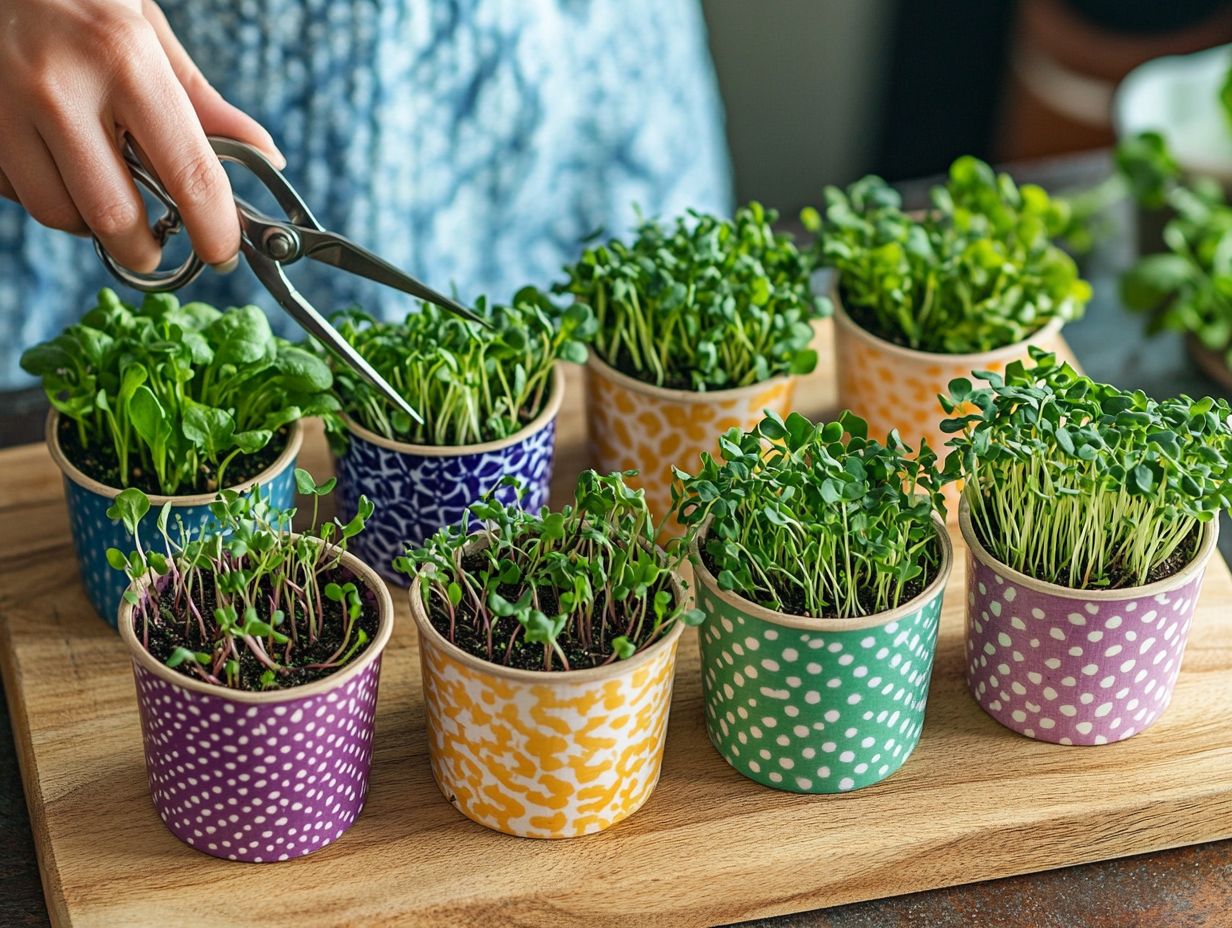
When selecting microgreens, grasp the growing conditions think soil types and hydroponic options along with your flavor preferences to ensure a successful harvest.
Light intensity and temperature are pivotal in shaping the growth and flavor profile of these nutrient-dense plants. For example, some microgreens flourish under bright light, boosting their nutritional value and vibrant color, while others thrive in a shadier setting to deliver optimal taste. If you’re interested in enhancing your microgreens cultivation, check out this guide on How to Use Hydroponics for Microgreens.
Your choice between soil and hydroponic methods can significantly influence not just the yield but also the texture and overall flavor of the microgreens. Don’t hesitate to experiment with different varieties; the peppery kick of arugula or the subtle sweetness of basil can elevate any dish. For a deeper understanding, refer to this step-by-step guide to sowing microgreens, making personalized flavor profiles a vital consideration in your microgreen selection.
Don’t miss out on the opportunity to enhance your meals! Start growing microgreens today and enjoy their many benefits.
When to Harvest Microgreens
Determining the best time to harvest microgreens is crucial for enhancing flavor and nutrition. The ideal moment for harvesting is just after the true leaves have emerged but before the plants mature. This careful timing ensures you reap the full benefits of these vibrant greens.
Timing for Maximum Flavor
The timing of your microgreens harvest is key to achieving maximum flavor. Many varieties are best harvested when the first true leaves begin to develop, as this is when they are most tender and packed with health benefits.
Understanding the growth stages of microgreens is key to harvesting the best flavor! They transition from seedling to mature plant in just a few weeks, with each stage offering unique flavors. At the cotyledon stage, microgreens present a milder taste. Waiting until the true leaves form ensures they reach their peak vibrancy and nutritional value. Additionally, employing proper watering techniques for thriving microgreens will help maximize their growth. Keep an eye on changes in color and leaf size as key indicators.
Harvesting at the right moment enhances flavor and boosts vitamins and antioxidants.
Harvesting Techniques
Using the correct harvesting techniques is essential for preserving the flavor and nutrient profile of microgreens. You have various methods at your disposal, from straightforward cutting to advanced techniques tailored to specific microgreen varieties.
Methods for Optimal Flavor and Nutrient Retention
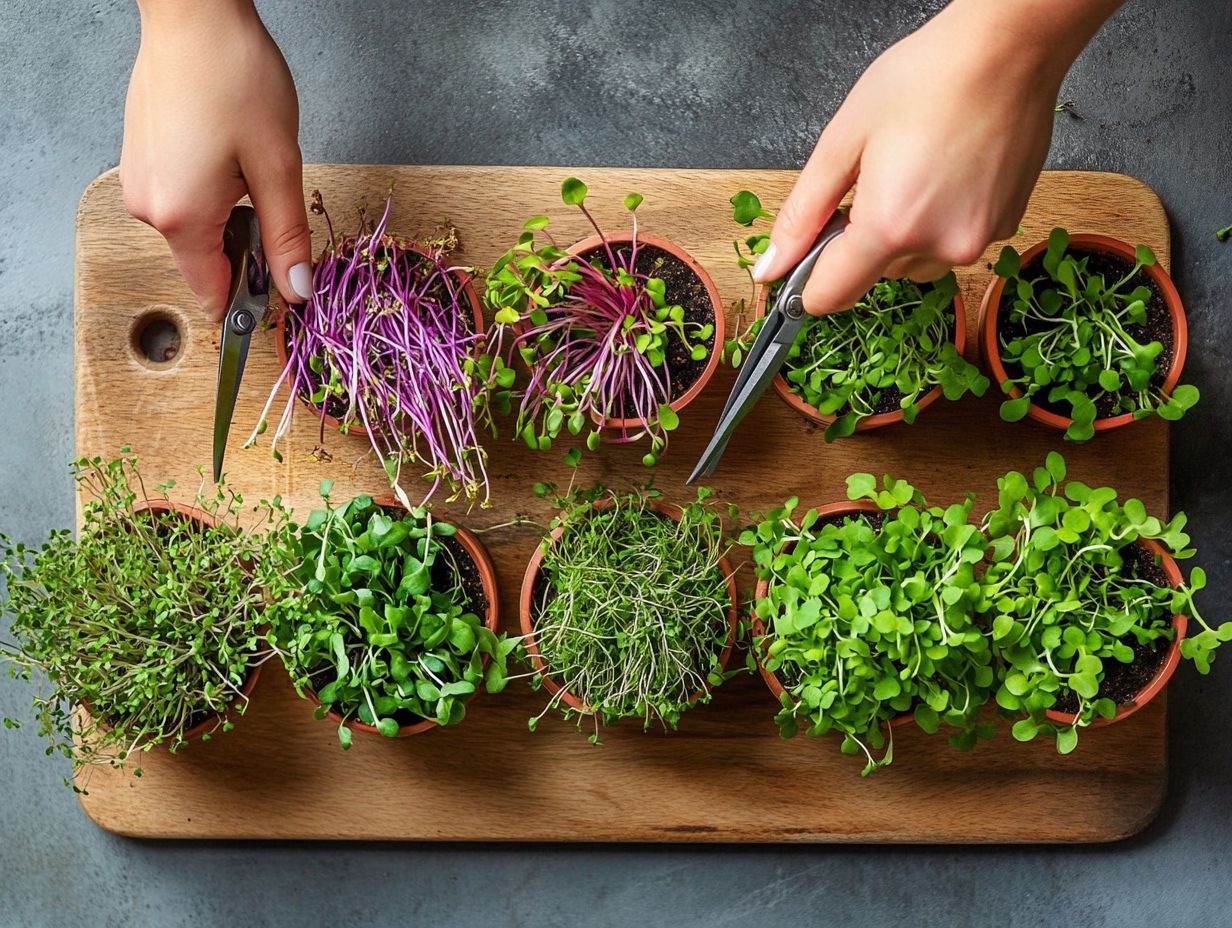
To achieve optimal flavor and nutrient retention when harvesting microgreens, embrace precise techniques that minimize damage to delicate seedlings while preserving their vibrant qualities.
One effective approach is to use sharp, sanitized scissors or a knife for cutting. This ensures a clean cut and reduces the risk of crushing stems. Timing is crucial; harvesting just before microgreens reach full maturity locks in their peak flavors and nutrients. For optimal results, consider the perfect light conditions for microgreens. Working in the early morning, when the plants are well-hydrated, promotes a crisper texture that elevates the experience.
By employing these targeted harvesting techniques, you can maximize quality, enhancing both enjoyment and health benefits of these nutrient-dense greens.
Storing and Using Harvested Microgreens
Store and use harvested microgreens properly to keep them fresh and flavorful. This involves careful washing and drying techniques, allowing you to incorporate these vibrant greens into a variety of delightful recipes and salads.
Tips for Proper Storage and Creative Uses
For the best results, follow essential tips for storing microgreens, including effective washing techniques, drying methods, and innovative culinary uses to elevate your salads and other dishes.
Begin by rinsing your microgreens gently under cool running water to remove any soil or grit. A salad spinner works wonders, ensuring they are thoroughly dried without risk of bruising.
Once dried, store the microgreens in a breathable container lined with a paper towel to absorb excess moisture and prolong freshness.
These vibrant greens can enhance various meals consider tossing them into omelets for added texture, folding them into fresh salsas, or using them as a colorful garnish atop sandwiches. Their versatility boosts nutrition and adds a delightful pop of flavor to your culinary creations, making them perfect for many meals.
Frequently Asked Questions
What are microgreens?

Microgreens are young, edible plants, often called seedlings, that are harvested after the first few leaves have sprouted. They are packed with flavor and nutrients, making them a great addition to salads, sandwiches, and other dishes.
Try incorporating microgreens into your next meal for a burst of flavor and nutrition!
Why is it Important to Harvest Microgreens for Optimal Flavor?
Harvesting microgreens at the right time ensures the best flavor. This boosts their culinary appeal.
If you harvest too early, the full flavor won’t develop. On the flip side, waiting too long can make them bitter or tough.
How Do I Know When My Microgreens Are Ready to Be Harvested?
The ideal time to harvest is when the first true leaves have fully formed. These are the second set of leaves that grow after the initial leaves, called cotyledons.
True leaves are about 1-2 inches tall, signaling optimal taste.
What Is the Best Way to Harvest Microgreens?
Use clean scissors or a sharp knife to harvest microgreens. Cut gently to avoid damaging neighboring plants.
Trim the stems just above the soil level. Avoid pulling them out by the roots, as this can disturb others and impact growth.
Can I Harvest Microgreens More Than Once?
Yes! You can typically harvest them 1-2 times before they lose flavor and nutrition. Just cut the stems above the soil level, leaving some intact.
This allows them to regrow for another harvest in 1-2 weeks!
How Should I Store Harvested Microgreens for Optimal Flavor?
To keep your microgreens fresh and flavorful, store them in a sealed container or bag in the refrigerator. They can stay fresh for up to 5 days!
For best results, wait to wash them until you’re ready to eat. This prevents wilting and helps them last longer.

